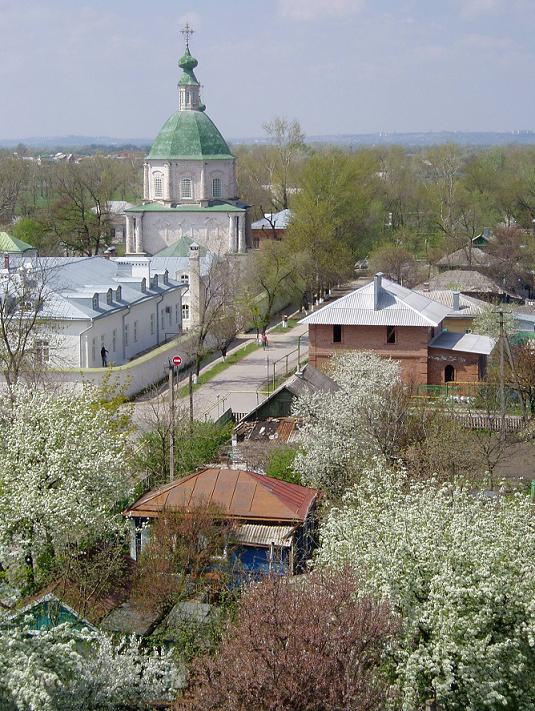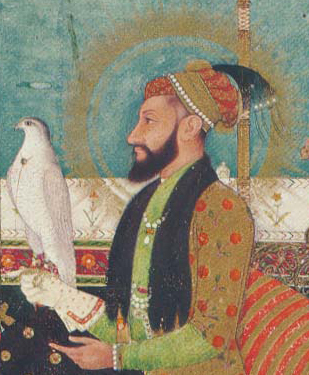|
Kondraty Bulavin House
The Kondraty Bulavin house, or Bulavin house () is a historical building located not far from the main square of Starocherkasskaya. History The house is reputed to have been the place where Kondraty Bulavin, the leader of the Bulavin Rebellion, a peasant war between 1707-1709 lived and died. The house was not Bulavin's property, but was requisitioned by him in 1708 after his capture of Cherkassk and his proclamation as ataman. The house is an example of stone residential architecture of the first half of the 18th century. The building is square, the walls are about a meter thick, there are vaulted ceilings, lattice windows, and metal doors. These are the signs of a fortified house. Since the October Revolution The October Revolution,. officially known as the Great October Socialist Revolution. in the Soviet Union, also known as the Bolshevik Revolution, was a revolution in Russia led by the Bolshevik Party of Vladimir Lenin that was a key mome ... in 1917, the bui ... [...More Info...] [...Related Items...] OR: [Wikipedia] [Google] [Baidu] |
Starocherkasskaya
Starocherkasskaya (russian: Старочерка́сская), formerly Cherkassk (), is a rural locality (a ''stanitsa'') in Aksaysky District of Rostov Oblast, Russia, with origins dating from the late 16th century. It is located on the right bank of the Don River approximately upstream from the major Russian port city of Rostov-on-Don. It is famous for having been the center of Don Cossack culture and politics for nearly two centuries as the capital of the Don Host Oblast. Due to regular spring floods that submerged the small city on several occasions, the Cossacks moved their capital to higher ground at Novocherkassk in 1805. In and around Starocherkasskaya there are over forty noteworthy historical and cultural sites including the Resurrection (Voskresensky) Cathedral, completed in 1719, and its famous gilded wooden iconostasis. History A Cossack fortress on the island of what was later called ''Monastyrsky'' on the Don river was probably built before 1570 although it is ... [...More Info...] [...Related Items...] OR: [Wikipedia] [Google] [Baidu] |
Rostov Oblast
Rostov Oblast ( rus, Росто́вская о́бласть, r=Rostovskaya oblast, p=rɐˈstofskəjə ˈobləsʲtʲ) is a federal subject of Russia (an oblast), located in the Southern Federal District. The oblast has an area of and a population of 4,277,976 ( 2010 Census), making it the sixth most populous federal subject in Russia. Its administrative center is the types of inhabited localities in Russia, city of Rostov-on-Don, which also became the administrative center of the Southern Federal District in 2002. Geography Rostov Oblast borders Ukraine (Donetsk Oblast, Donetsk and Luhansk Oblasts) and also Volgograd Oblast, Volgograd and Voronezh Oblasts in the north, Krasnodar Krai, Krasnodar and Stavropol Krais in the south, and the Republic of Kalmykia in the east. The Rostov oblast is located in the Pontic–Caspian steppe, Pontic-Caspian steppe. It is directly north over the North Caucasus and west of the Yergeni hills.Google Earth It is within the Russian Southern Fede ... [...More Info...] [...Related Items...] OR: [Wikipedia] [Google] [Baidu] |
Kondraty Bulavin
The Bulavin Rebellion or Astrakhan Revolt (; Восстание Булавина, ''Vosstaniye Bulavina'') was a war which took place in the years 1707 and 1708 between the Don Cossacks and the Tsardom of Russia. Kondraty Bulavin, a democratically elected Ataman of the Don Cossacks, led the Cossack rebels. The conflict was triggered by a number of underlying tensions between the Moscow government under Peter I of Russia, the Cossacks, and Russian peasants fleeing from serfdom in Russia to gain freedom in the autonomous Don area. It started with the 1707 assassination of Prince , the leader of Imperial army's punitive expedition to the Don area, by Don Cossacks under Bulavin's command. The end of the rebellion came with Bulavin's death in 1708. Underlying causes A number of social grievances were prevalent in the peasant population of Russia in the years leading up to the Bulavin Rebellion. Peter the Great's radical reforms designed to "Westernize" old Muscovy in the 18th ... [...More Info...] [...Related Items...] OR: [Wikipedia] [Google] [Baidu] |
Bulavin Rebellion
The Bulavin Rebellion or Astrakhan Revolt (; Восстание Булавина, ''Vosstaniye Bulavina'') was a war which took place in the years 1707 and 1708 between the Don Cossacks and the Tsardom of Russia. Kondraty Bulavin, a democratically elected Ataman of the Don Cossacks, led the Cossack rebels. The conflict was triggered by a number of underlying tensions between the Moscow government under Peter I of Russia, the Cossacks, and Russian peasants fleeing from serfdom in Russia to gain freedom in the autonomous Don area. It started with the 1707 assassination of Prince , the leader of Imperial army's punitive expedition to the Don area, by Don Cossacks under Bulavin's command. The end of the rebellion came with Bulavin's death in 1708. Underlying causes A number of social grievances were prevalent in the peasant population of Russia in the years leading up to the Bulavin Rebellion. Peter the Great's radical reforms designed to "Westernize" old Muscovy in the 18th cent ... [...More Info...] [...Related Items...] OR: [Wikipedia] [Google] [Baidu] |
1700s (decade)
The 1700s decade ran from January 1, 1700, to December 31, 1709. The decade is marked by a shift in the political structure of the Indian subcontinent, and the decline of the Mughal Empire The Mughal Empire was an early-modern empire that controlled much of South Asia between the 16th and 19th centuries. Quote: "Although the first two Timurid emperors and many of their noblemen were recent migrants to the subcontinent, the .... References {{DEFAULTSORT:1700s ... [...More Info...] [...Related Items...] OR: [Wikipedia] [Google] [Baidu] |
Ataman
Ataman (variants: ''otaman'', ''wataman'', ''vataman''; Russian: атаман, uk, отаман) was a title of Cossack and haidamak leaders of various kinds. In the Russian Empire, the term was the official title of the supreme military commanders of the Cossack armies. The Ukrainian version of the same word is ''hetman''. ''Otaman'' in Ukrainian Cossack forces was a position of a lower rank. Etymology The etymologies of the words ''ataman'' and ''hetman'' are disputed. There may be several independent Germanic and Turkic origins for seemingly cognate forms of the words, all referring to the same concept. The ''hetman'' form cognates with German '' Hauptmann'' ('captain', literally 'head-man') by the way of Czech or Polish, like several other titles. The Russian term ''ataman'' is probably connected to Old East Slavic ''vatamanŭ,'' and cognates with Turkic ''odoman'' (Ottoman Turks). The term ''ataman'' may had also a lingual interaction with Polish ''hetman'' and German ... [...More Info...] [...Related Items...] OR: [Wikipedia] [Google] [Baidu] |
October Revolution
The October Revolution,. officially known as the Great October Socialist Revolution. in the Soviet Union, also known as the Bolshevik Revolution, was a revolution in Russia led by the Bolshevik Party of Vladimir Lenin that was a key moment in the larger Russian Revolution of 1917–1923. It was the second revolutionary change of government in Russia in 1917. It took place through an armed insurrection in Petrograd (now Saint Petersburg) on . It was the precipitating event of the Russian Civil War. The October Revolution followed and capitalized on the February Revolution earlier that year, which had overthrown the Tsarist autocracy, resulting in a liberal provisional government. The provisional government had taken power after being proclaimed by Grand Duke Michael, Tsar Nicholas II's younger brother, who declined to take power after the Tsar stepped down. During this time, urban workers began to organize into councils ( soviets) wherein revolutionaries criticized t ... [...More Info...] [...Related Items...] OR: [Wikipedia] [Google] [Baidu] |
Tourist Attractions In Rostov Oblast
Tourism is travel for pleasure or business; also the theory and practice of touring, the business of attracting, accommodating, and entertaining tourists, and the business of operating tours. The World Tourism Organization defines tourism more generally, in terms which go "beyond the common perception of tourism as being limited to holiday activity only", as people "travelling to and staying in places outside their usual environment for not more than one consecutive year for leisure and not less than 24 hours, business and other purposes". Tourism can be domestic (within the traveller's own country) or international, and international tourism has both incoming and outgoing implications on a country's balance of payments. Tourism numbers declined as a result of a strong economic slowdown (the late-2000s recession) between the second half of 2008 and the end of 2009, and in consequence of the outbreak of the 2009 H1N1 influenza virus, but slowly recovered until the COVID-19 ... [...More Info...] [...Related Items...] OR: [Wikipedia] [Google] [Baidu] |
Buildings And Structures In Rostov Oblast
A building, or edifice, is an enclosed structure with a roof and walls standing more or less permanently in one place, such as a house or factory (although there's also portable buildings). Buildings come in a variety of sizes, shapes, and functions, and have been adapted throughout history for a wide number of factors, from building materials available, to weather conditions, land prices, ground conditions, specific uses, prestige, and aesthetic reasons. To better understand the term ''building'' compare the list of nonbuilding structures. Buildings serve several societal needs – primarily as shelter from weather, security, living space, privacy, to store belongings, and to comfortably live and work. A building as a shelter represents a physical division of the human habitat (a place of comfort and safety) and the ''outside'' (a place that at times may be harsh and harmful). Ever since the first cave paintings, buildings have also become objects or canvasses of much artistic ... [...More Info...] [...Related Items...] OR: [Wikipedia] [Google] [Baidu] |
Museums In Rostov Oblast
A museum ( ; plural museums or, rarely, musea) is a building or institution that cares for and displays a collection of artifacts and other objects of artistic, cultural, historical, or scientific importance. Many public museums make these items available for public viewing through exhibits that may be permanent or temporary. The largest museums are located in major cities throughout the world, while thousands of local museums exist in smaller cities, towns, and rural areas. Museums have varying aims, ranging from the conservation and documentation of their collection, serving researchers and specialists, to catering to the general public. The goal of serving researchers is not only scientific, but intended to serve the general public. There are many types of museums, including art museums, natural history museums, science museums, war museums, and children's museums. According to the International Council of Museums (ICOM), there are more than 55,000 museums in 202 countr ... [...More Info...] [...Related Items...] OR: [Wikipedia] [Google] [Baidu] |






